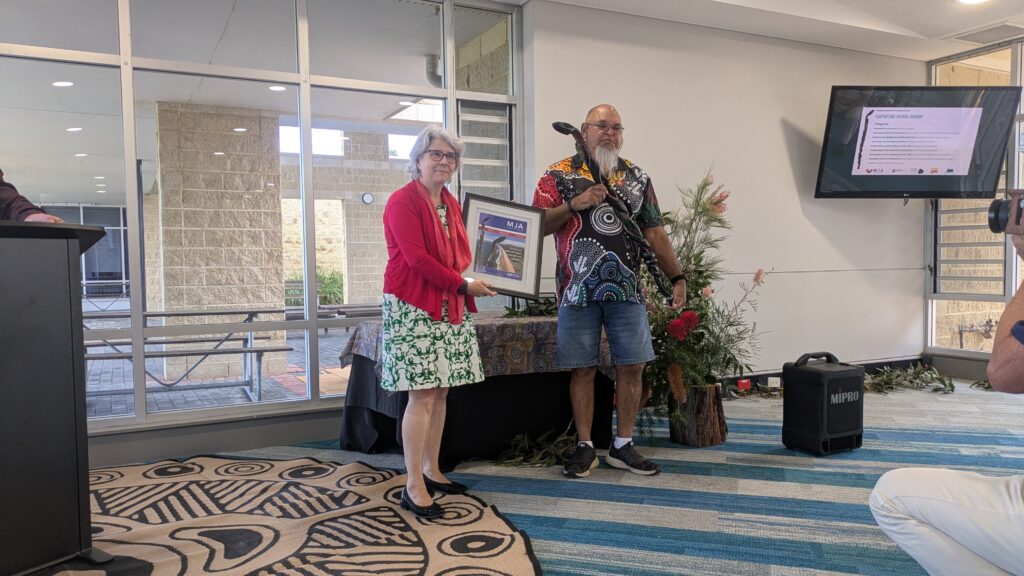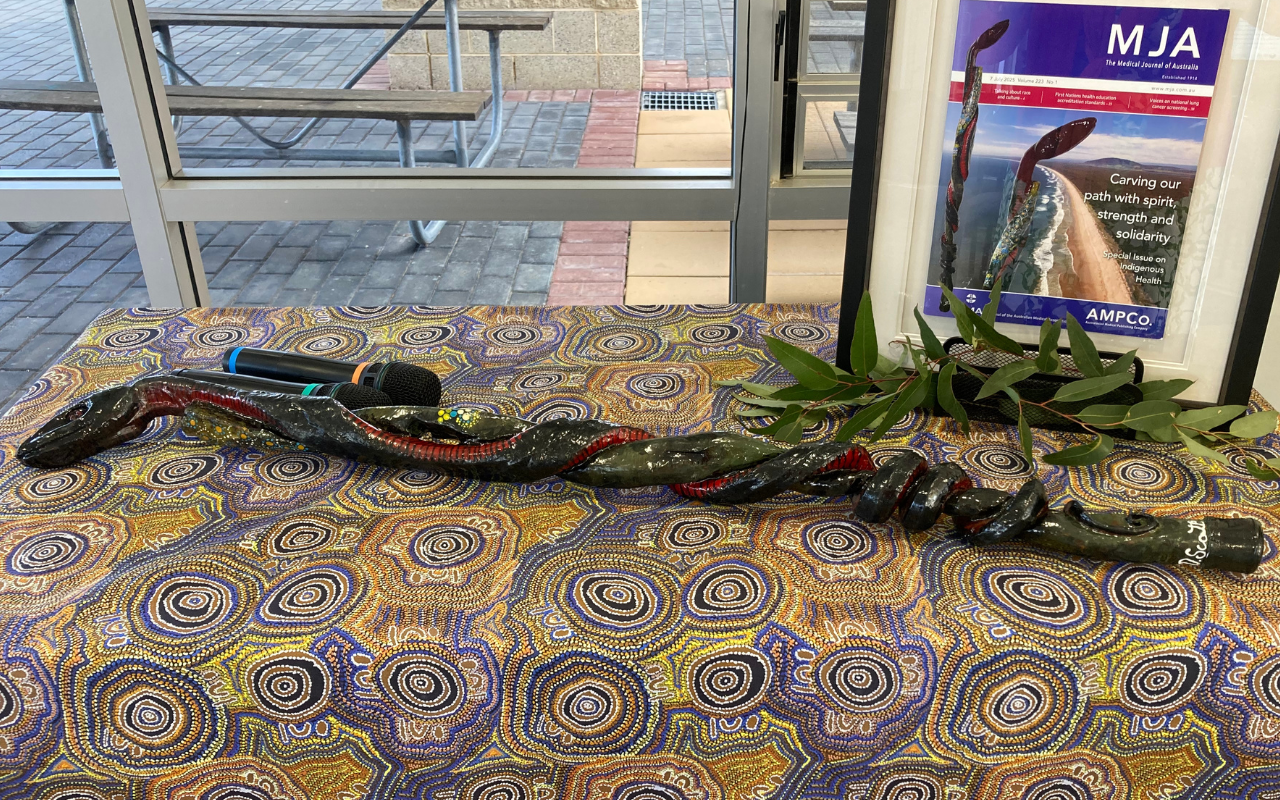Representatives from the Medical Journal of Australia attended the First Nations Cultural Sharing Gathering to celebrate the NAIDOC Week issue of the journal.
Last week, we were honoured to be part of a ceremony at the beautiful University of Wollongong campus on the lands of the Wandi Wandian and Dharawal Peoples, to receive the walking stick from Uncle Paul Scott who carved it for the 2025 Special Issue on Indigenous Health – Carving our path with spirit, strength and solidarity.
The ceremony was attended by Uncle Paul and his family and community, staff from the University of Wollongong, including Professor Eileen McLaughlin, Professor Zsuzsoka Kecskes and Associate Professor Paul Saunders who was one of the guest editors of the Special issue. I attended with two colleagues from the MJA, Liz Zuccala and Kate Steyn and two of the AMPCo Board, Steve Lennon and Petra Buchanan.

Uncle Paul Scott spoke powerfully about his life, and in the issue, you can see his history of the walking stick.
In my speech I reflected on the past of the MJA as a colonial institution and its role for a long time in perpetuating racism in medicine in Australia, including at first the racism of invisibility, which is clearly reflected in the early history of the MJA in regard to lack of meaningful representation of Aboriginal and Torres Strait Islander health. Until very recently, the MJA has largely been part of the colonial system that promoted a deficit approach to Aboriginal and Torres Strait Islander health, and papers we published were still largely reports of research done on Aboriginal and Torres Strait Islander health communities but not led by them, and too often with just a token Aboriginal or Torres Strait Islander author.
Over the past two years, we have tried to take a different approach, which is described by last year’s NAIDOC week issue, which had as its theme “Centring Indigenous Knowledges”. As part of that issue’s process the selection of papers was done entirely by a team of Aboriginal and Torres Strait Islander health academics – our role at the MJA was to support the process. Essentially, we recognised that a meaningful approach to improve the ethical publishing practices at MJA required that the Journal relinquish control and hand over decision making to Aboriginal and Torres Strait Islander experts.
Though these are difficult but important topics to talk about, the event was really joyful, with a welcome to country from Rodney Carpenter, dancing from the Nowra High School Gadhungai Maring Dance Troupe and great connections made across the day. We are grateful to the many people who made the event possible, especially Paul Saunders and Ashlee Williams-Barnes.
As well as these two NAIDOC week issues, our latest MJA issue features a powerful editorial from Sophie Pitt that reflects on the 18th anniversary of the United Nations Declaration on the Rights of Indigenous Peoples.
We are deeply grateful for the generosity, time and expertise of the team of Aboriginal and Torres Strait Islander Guest Editors for the special issue this year: Professor Pat Dudgeon (Bardi), Professor Jaquelyne Hughes (Wagadagam), Associate Professor Michelle Kennedy (Wiradjuri), Professor Kelvin Kong (Worimi), Professor Odette Pearson (Eastern Kuku‐Yalanji and Torres Strait Islander), and Associate Professor Paul Saunders (Biripi).
At the MJA, I’m lucky enough to work with a really committed team and I am grateful for everyone there who has supported this work. Collectively, we acknowledge the importance of self-determination and Indigenous knowledges, and are committed to the ongoing work we need to do to advance Aboriginal and Torres Strait Islander health research leadership, governance and participation through the work that we publish and our publishing practices.
Professor Virginia Barbour is the editor-in-chief of the Medical Journal of Australia.
Subscribe to the free InSight+ weekly newsletter here. It is available to all readers, not just registered medical practitioners.

 more_vert
more_vert
Thank you for your honest acknowledgement, Professor Barbour and for the good work you and your team are doing. The MJA was always difficult to read for me in the past (and not because I lack scientific or academic literacy).
As a keen, mature-aged Aboriginal science and medical student (and then a doctor) I eventually let my subscription lapse (more than once) because of the alienating assumptions embodied in the journal’s presentation.
It’s good to live long enough to see positive change.
As the MJA begins and learns to be more inclusive we can look forward to greater salience of Indigenous values, and of our knowledge, furthering the healing needed for all of us living in these islands now called Australia.
Looking forward to reading Uncle Paul’s story–the walking stick is impressive. And Sophie Pitt’s fiery editorial.